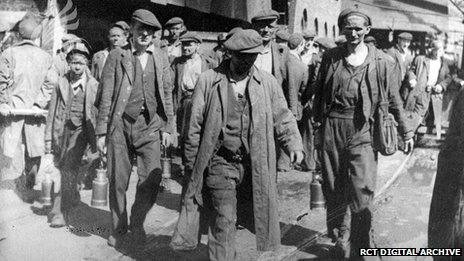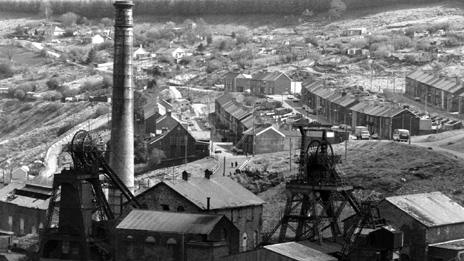Plaque marks nine 1956 Lewis Merthyr pit deaths
- Published

Ivor England, who will give a reading at the dedication, remembers a 'whoosh' of air as the methane exploded in the pit
Nine men killed in a south Wales mining disaster 55 years ago are to be commemorated with a plaque, in a service which one of the survivors says still has particular resonance.
Ivor England was working in a different part of the Lewis Merthyr pit on the morning of 22 November, 1956, when a rock fall in the Trefor complex ignited a methane explosion.
The 75-year-old will give a reading at the plaque unveiling at Rhondda Heritage Park in Trehafod, a mining museum which now stands on the pit's site.
While his thoughts will be with the colleagues he lost that day, Ivor believes everyone involved in mining should stop and think for a moment.
Mr England, who was on the day shift, recalls the exiting night shift warning how treacherous conditions were in the Trefor pit.
Trapped pockets
Over the previous few weeks they had encountered a "jump" in the 2ft 9in (0.84m) seam, where the coal suddenly rises, creating a geographical fault.
The decision was taken to proceed with the heading, in an attempt to rejoin the coal seam.
But conditions in the jump caused the roof to collapse; dropping boulders from above, and releasing trapped pockets of methane gas.

The colliery had a 'jump' in a narrow coal seam
Most of the colliers had been withdrawn from the area, but an advance team were sent in to try and shore up the roof with steel rings.
When one of the stray boulders struck a steel support ring, it sparked, igniting a methane explosion which was felt for miles around.
"I was well out of danger, but even in the Bertie pit, we felt this 'whoosh' of air, almost like you get before a tube train pulls into the station.
'Utterly useless'
"Well, it wasn't unusual to feel that, you got the same whenever there was shot firing, but put together with what the night shift had told us about conditions in Trefor, we just had a feeling in our guts that it wasn't good news.
"We were ordered back to the surface by the overman, and there was already police, ambulances and mines rescue crews arriving."
Two men were killed instantly, seven more died in hospital, but incredibly five of the victims survived the fireball which engulfed a 70 yard (64m) diameter.
"I just remember feeling utterly useless," said Mr England.

Mr England said he will remember 'all the victims of Welsh coal' during the ceremony
"You couldn't help but want to help, when you saw men being brought up burnt and bloody, but mines rescue told us to get out of the way and leave it to the experts.
"It just made you realise how random life is. I only joined Lewis Merthyr because they wanted me to play trombone for the colliery band, and on a different day I could have been working in that sector."
Mr England also believes it is fitting that the plaque is to be unveiled on the park which now commemorates all Rhondda's industrial past.
"Of course I'll be thinking of the men I knew, but it's not all about Lewis Merthyr."
"Four or five thousand men gave their lives for coal in Wales, and while it's the big disasters which everyone remembers, the vast majority of those died in ones and twos in accidents which no-one remembers.
"So when we have our minute's silence, I'll spare a thought for all the Welsh victims of coal."